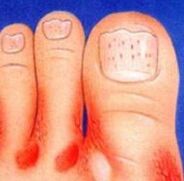According to statistics, every tenth resident of our planet suffers the fungus of the legs or, as it is also called epidermophtosis. Most of the time, men suffer from this disease, which is due more to the characteristics of physiology such as the fact that male representatives are more often and longer than women, wear closed shoes.
Leg fungus: causes and risk factors
The disease can be caused by one of the following reasons:

- insufficient body hygiene in particular and foot;
- uncomfortable and too close shoes;
- Excessive sweating of the feet;
- violations in the work of the human immune system;
- Flat feet and other types of feet deformation;
- use of pools and public bathrooms;
- insufficient hygiene and bath showers;
- Overweight;
- Problems with blood circulation in the legs.
General symptoms of foot fungus
The fungus in the legs can manifest in different ways:
- Skin inflammation on the heels and pillows of the feet;
- itching varying degrees;
- cracks;
- peeling.
A precise determination of the type of fungus that impressed at the feet will help choose the correct treatment of this disease.
Leg fungus and their types
In medicine, it is customary to secrete 3 main types of fungi: membrane, such as moccasin, vesicular. And each of them is inherent in general and characteristic symptoms.
Membrane fungus signs:
- Location in the fingers 4 and fifth;
- Characteristic of most types of fungi: scales;
- Itching
The fungus in the legs of the type of moccasin differs from others:
- thickening of the sole of the feet;
- deeper cracks;
- painful sensation;
- The damage to the nails, which, like the skin of the feet, swell, at the same time acquiring excessive fragility, which can even lead to the loss of the nail plate.

The vesicular fungus is characterized by: blisters full of fluid and location in the lower foot.
Foot fungus: diagnosis
The "fungus of the foot" diagnosis is made by a dermatologist based on the patient's exam. More detailed studies: scrapes, skin biopsy, cultivation: will help the doctor to determine precisely the type of fungus that impressed the patient. In addition to everything, the doctor performs a patient survey to manifest this disease in the past. The latter is especially important, since often recurring manifestations of the fungus for a certain period of time indicate the transition of the disease in a more serious way, which is more difficult to treat.
How to treat a fungus on your feet?
Fungal fungus therapy does not require stationary observation and is carried out in an outpatient way. In most cases, the patient is prescribed external antimicotic medications. It is worth noting that often people suffering from the foot of the foot do not resort to a specialist, just taking medications sold in a pharmacy without a recipe. This scenario often leads to a favorable result of the disease. However, it should be remembered that prolonged therapy of the disease, accompanied by a deterioration in the condition of the legs, indicates an advanced stage of the disease. The best way out of this situation will be to visit a specialist who will help choose the optimal fungal remedy.





























